- Blog
- How To Create Personalized Landing Pages For Increased Conversions
How To Create Personalized Landing Pages For Increased Conversions
-
Barbara Bartucz
- Personalization
- 6 min read
Table of Contents
Personalization strategies have come a long way in recent years. It’s no longer just about addressing users by name—it’s about crafting unique experiences for individual visitors who interact with your brand.
We’ve been exploring the strategies that make marketing campaigns truly effective, and one thing is clear: personalized landing pages are a game-changer. They set the tone for the customer journey, improve engagement, and drive conversions.
In this article, we’ll dive into the theory and practice of building personalized landing pages to wow your website visitors right out of the gate.
Let’s get started!
What are personalized landing pages?
Personalized landing pages are landing pages that adapt themselves to cater to the specific needs of individual users.
While a generic landing page (a.k.a. a static landing page) is the same for every user, a personalized landing page changes based on factors like a visitor’s location, interest level, or behavior.
That means that personalized landing pages can display different content, visuals, and calls-to-action for different potential customers.
Personalized content helps convert visitors by ensuring that your messaging is relevant to each individual.
How to create personalized landing pages?
Now that you know what personalized landing pages are, let’s take a look at three ways of building them.
1. Manual landing page personalization
The first way that you can create customized landing pages is through manual landing page personalization. This approach usually relies on website builders or dedicated landing page builders.
Essentially, what you’ll do is create a series of different landing pages for a variety of different target audiences. You can create a basic landing page and then create multiple versions of it by using different headlines, subheadlines, and tailored images for each different segment of website visitors.
Then, you can show one of these different static landing pages to each segment, allowing you to show personalized content to each potential customer.
Although many online marketers use this method, it’s very time and resource intensive because you have to create all the pages yourself.
2. Personalize your landing pages using dynamic content
Instead of creating many different versions of a landing page, you can use a dynamic landing page to create personalized experiences with just one version. Dynamic content allows you to personalize only certain parts of the landing page.
Using a tool like OptiMonk and its Dynamic Content, you can select the landing page sections you want to personalize and rewrite them for different target audiences.


For example, you can write personalized calls-to-action for different audiences, which can help you increase conversions significantly.
In this case, all you need to do is use “Visited URL” targeting to show your personalized landing page to the right visitor segment.
3. Dynamically personalize your landing pages with the power of AI
The fastest solution is personalizing landing pages through AI-driven personalization, which starts with collecting customer data, analyzing it, and then leveraging this information to deliver highly personalized experiences.
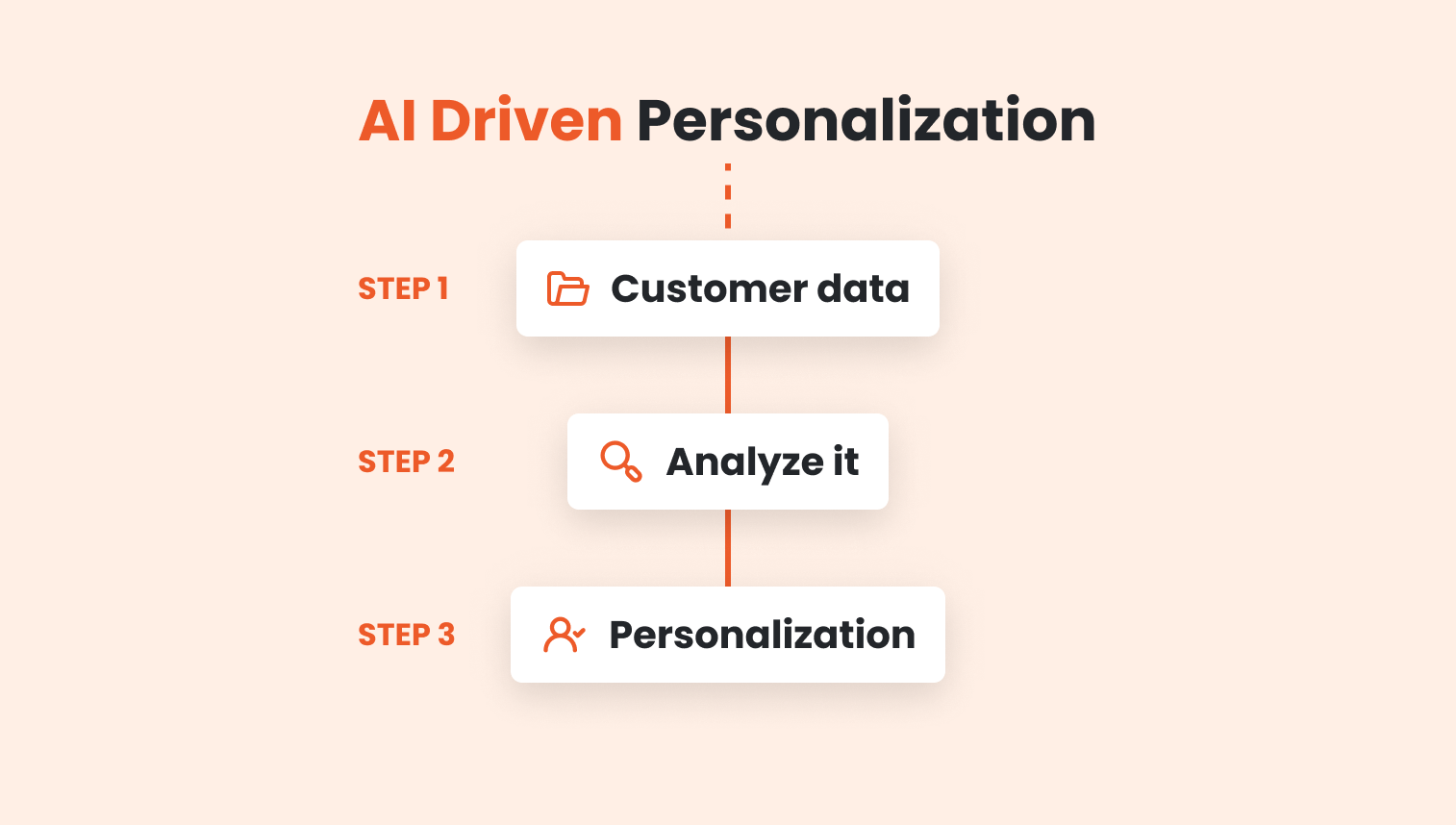
By using the right tools, like OptiMonk’s Smart Personalizer, you can entirely remove the hassle of manual personalization.
You just create one campaign, pick the elements you want to personalize, and hit the launch button. AI will automatically personalize your headlines based on the ads each visitor has clicked on.
Book a demo now to find out more about Smart Personalizer.
What to base your landing page personalization on?
Creating dynamic landing pages is all about speaking directly with your visitors. But what factors should you use to personalize landing pages?
Here are 8 factors you can use when creating personalized landing pages.
1. Demographics
Tailoring your landing page content based on demographics involves creating a personalized experience that resonates with specific groups.
Relevant demographics in ecommerce can include:
- age,
- gender,
- and level of income.
For instance, gender-specific customization uses imagery and language that aligns with the gender of your target audience, ensuring a relatable and personalized experience for both male and female visitors.
2. Geographic location
A visitor’s location is an incredibly valuable kind of third-party data that you can use to create dynamic landing pages. It’s possible to improve your conversion rate by including a marketing message that mentions where your traffic is coming from.
For example, you can include a section that automatically updates a “We ship to “ element, helping visitors shop with confidence.
Amazon is a great example of using geographic location:

3. Behavioral data
You can also target based on individual users’ past behavior, allowing you to speak directly to specific buyer personas and deliver them relevant content.
By showcasing products or services related to a visitor’s previous engagement, you create a seamless sales funnel.
For example, implementing a personalized popup for returning visitors that shows them their previously viewed product(s) can further enhance the tailored experience.
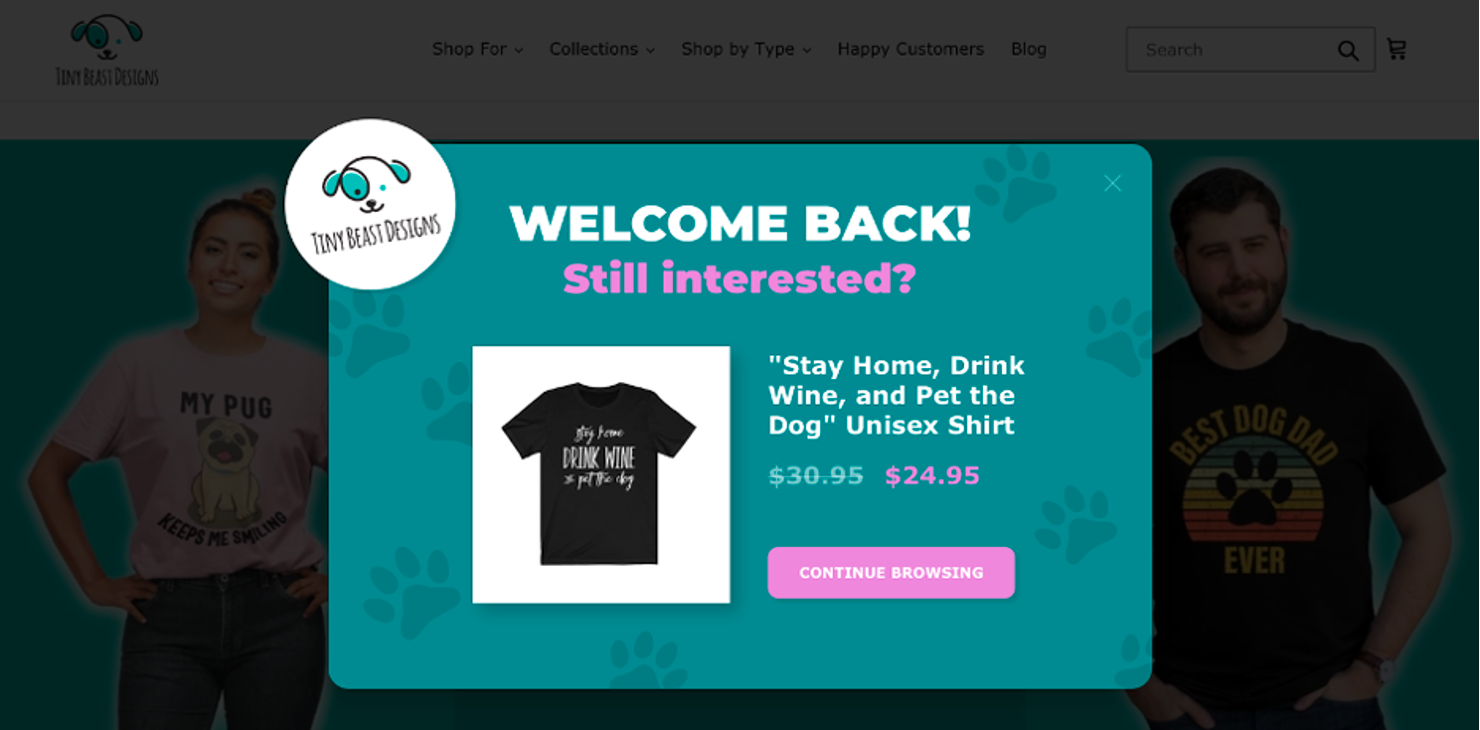
4. Purchase history
Personalizing your landing page based on a visitor’s purchase history is a powerful strategy to drive repeat business.
Recommending complementary products based on a visitor’s previous purchases also increases the likelihood of successful upsells and/or cross-sells, maximizing the value of each customer interaction.
Amazon’s “Because you have been reading similar books” is a great example of recommending products based on purchase history:

5. Referral source
You can also use referring websites in your personalized landing pages by acknowledging and reinforcing the specific reasons visitors clicked through from a particular channel.
Implementing referral-specific landing pages with content that directly addresses the needs or expectations set by the referring source—whether it’s a Google search or Instagram campaign—creates a seamless transition for the visitor, increasing the chances of engagement and conversion.
If you have a considerable amount of traffic coming from referral partners, you can even tailor your landing pages to your top referral partners, like in the example below:
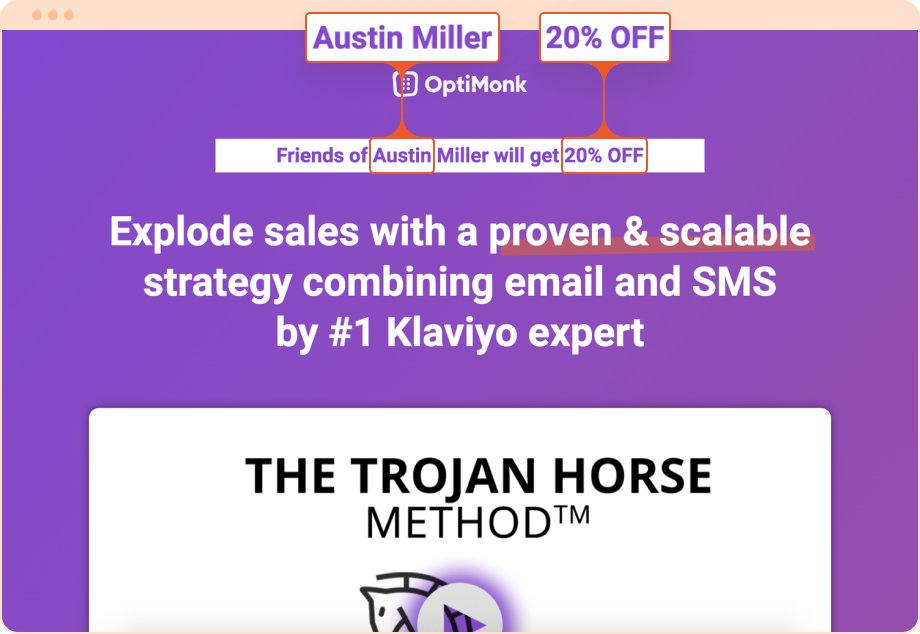
6. Interests and hobbies
It’s always a good idea to collect data with personalized landing pages in mind, since knowing what your customers care about allows you to showcase products or content that align with their passions.
Providing personalized content recommendations based on inferred interests from previous browsing behavior enhances the overall user experience, making the landing page more engaging and relevant to individual preferences.
7. Device and platform
Optimizing your landing page for different devices and platforms, especially for mobile users, is crucial for delivering a top-notch user experience, especially when you consider that many of your customers will be visiting your site from a mobile device.
Ensuring that your layout adapts to various screen sizes and resolutions will contribute to the satisfaction of all users.
8. Abandoned cart data
Keeping track of the contents of carts that your visitors have abandoned can help you re-engage them.
That can be through sending targeted follow-up emails with personalized incentives, such as discounts on items left in the cart, or putting similar messages onto a personalized landing page.
Keeping people interested in your products over a period of time can help raise your conversion rate among customers who aren’t ready to make a purchase immediately.
6 steps to creating personalized landing pages
Landing page optimization is an important part of running an online store.
Here are the steps you’ll need to follow to ensure that your site makes a strong impression on your audience from the moment they land!
Step 1: Define your target audience
In order to create high-quality and compelling dynamic landing pages, you need to have a strong understanding of your customers.
Putting together buyer personas for your most important segments can help you discover the kind of messaging that will resonate with different parts of your target audience.
Step 2: Gather user data
Like all other personalized ad campaigns, a personalized landing page can only be successful if high-quality data is backing it up.
You can gather third-party data through Google Analytics and software like Hotjar in order to inform your demographic personalization.
You should also endeavor to collect first-party data on your own site by running survey campaigns and leveraging the information you collect when users take steps like registering for a free account.
Step 3: Set clear objectives
Every time you create a dynamic landing page, you should be crystal clear about the next step you want your user to take.
For some online businesses, this goal will be an immediate purchase, but for others, it might be creating an account or consuming educational content.
Although your conversion goal might differ depending on your business, it’s important that you know what it is. That’s because in the next step, you’re going to have to think very hard about the best way to convince different audience segments to take your desired action.
Step 4: Choose personalization variables
At this point, you need to figure out which elements of your landing page to personalize in order to make the greatest impact.
Exactly what you should personalize depends on both your conversion goal and the customer segments you’re dealing with.
Common elements to personalize include:
- The call-to-action
- Copy
- Images
- Product descriptions
- Headlines
Step 5: Select a personalization platform
In order to implement your personalized landing pages, you’ll need to choose a personalization platform such as OptiMonk.
You’ll want to make sure that the platform has the tools you need to personalize the elements you’re planning to include.
If you want to avoid doing the extra work of making many copies of your landing pages, choose a platform that uses a dynamic content approach to personalization.
It’s also worth taking a look at whether the platform has a large template library and how much technical expertise you’ll need to use it.
Step 6: Monitor and analyze
Finally, it’s important that you monitor the performance of your personalized landing page over time. This means that you should keep tabs on your performance data and investigate any drops in performance.
You can also use this step to continue optimizing your landing pages further by looking for more segmentation opportunities and running more A/B tests.
2 quick and proven tips for personalized landing pages
Here are two ways of quickly and easily creating dynamic landing pages based on where your traffic is coming from—no technical expertise is required!
1. Personalize your landing pages to your ads
If you run many paid Google search or social ads, you should create content for your landing pages that match with those campaigns.
For example, if one of your ads mentions that your products can help people regrow hair, your landing page should mention that USP. Failing to reflect the interest that drove a potential customer to your site can lead to high bounce rates.
This also means that ads featuring other USPs should have their own copy, like in the example below.
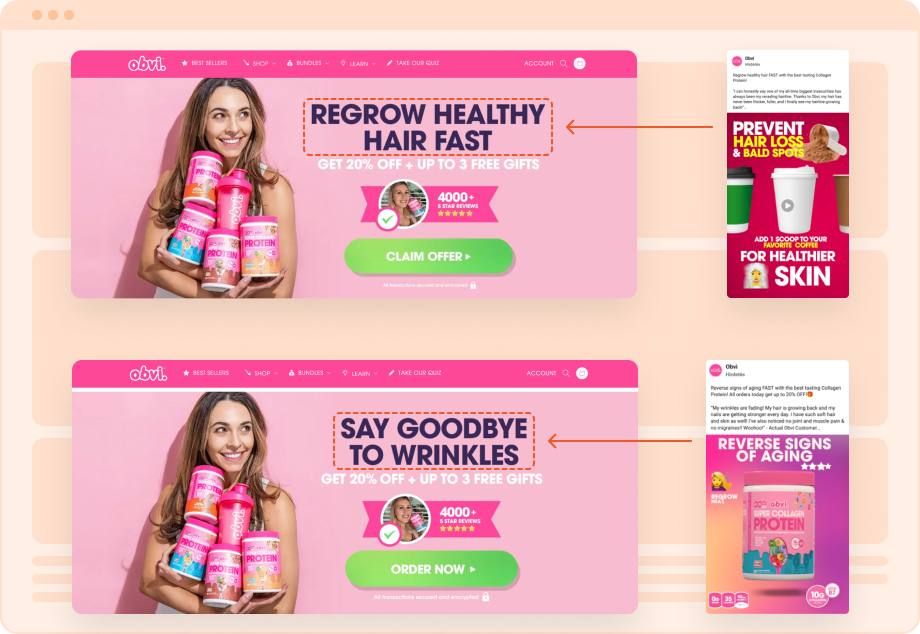
2. Personalize your email marketing landing pages
Using OptiMonk’s personalized greetings system, you can leverage the customer data you have on your email subscribers. This helps you establish a personal relationship with your leads and pique their interest in your offer.
B2B businesses will often use the company name of their leads instead of a person’s name.
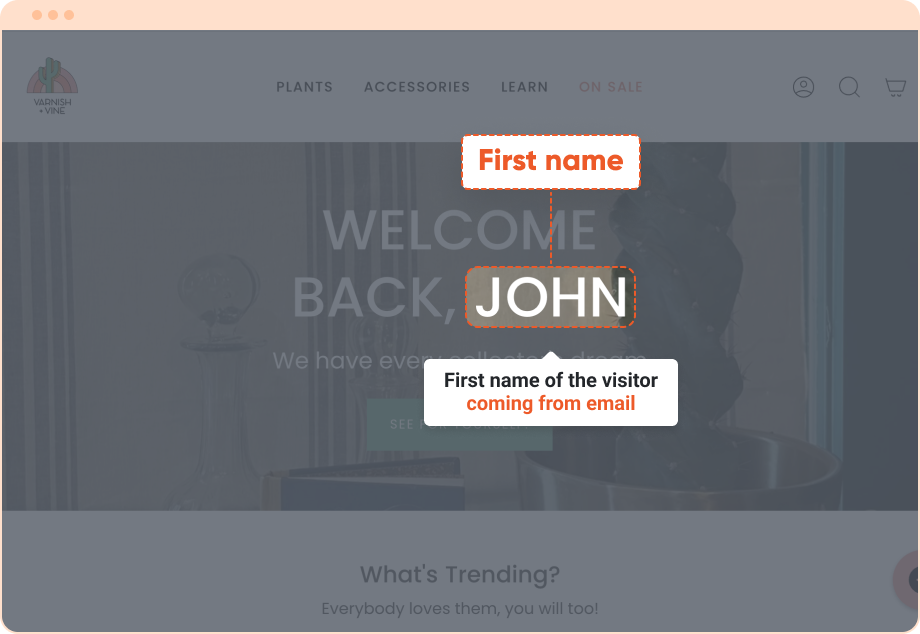
FAQ
What should be included in a personalized landing page?
Personalized landing pages should include a compelling headline, tailored content that’s relevant to the visitor’s interests or demographic profile, a clear next step, visually appealing design, and elements that foster trust, such as testimonials or trust badges.
Additionally, incorporate personalized elements like dynamic content, personalized offers, and interactive features to enhance user engagement and conversion rates.
Can you build a landing page for free?
Yes, you can build a landing page for free using various online tools that offer free website builders.
Popular options include Wix and Weebly. These platforms provide basic features and templates to create a simple landing page, but the free versions may have limitations.
What are some common mistakes to avoid in personalized landing pages?
Common mistakes to avoid in personalized landing pages include unclear or irrelevant content, excessive personalization that feels intrusive, slow page load times, lack of mobile optimization, and confusing or overwhelming design.
Additionally, failing to test and analyze the performance of your personalized elements can hinder the effectiveness of your landing page.
Closing thoughts
Hopefully you’ve learned something from this guide to creating personalized landing pages!
AI-powered personalization can help you leverage all the data you have at your disposal and provide your visitors with memorable experiences.
If you’d like to create personalized landing pages quickly and easily, request a demo today and get started!
Migration has never been easier
We made switching a no-brainer with our free, white-glove onboarding service so you can get started in the blink of an eye.

What should you do next?
Thanks for reading till the end. Here are 4 ways we can help you grow your business:
Boost conversions with proven use cases
Explore our Use Case Library, filled with actionable personalization examples and step-by-step guides to unlock your website's full potential. Check out Use Case Library
Create a free OptiMonk account
Create a free OptiMonk account and easily get started with popups and conversion rate optimization. Get OptiMonk free
Get advice from a CRO expert
Schedule a personalized discovery call with one of our experts to explore how OptiMonk can help you grow your business. Book a demo
Join our weekly newsletter
Real CRO insights & marketing tips. No fluff. Straight to your inbox. Subscribe now
Barbara Bartucz
- Posted in
- Personalization
Partner with us
- © OptiMonk. All rights reserved!
- Terms of Use
- Privacy Policy
- Cookie Policy
Product updates: January Release 2025








